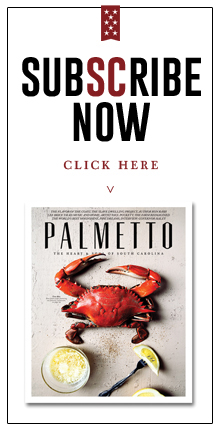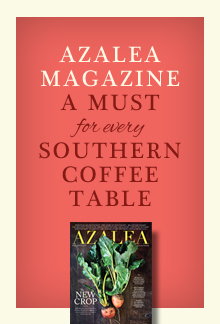
Chairman of the Board
Surfboard shaper Josh Hoke finds his balance in Charleston.
Josh Hoke paid attention in geometry class. In fact, it played a prominent role in his high school senior project. “We had to pick something to research and then create a final product based on what we learned, so I picked a surfboard,” he says. Noting the angles of surfboards and how they work with the movement of the waves, Hoke successfully shaped a board that he still rides today. He was awarded an ‘A’ for that first handcrafted board, and took his newfound skill with him to college at Indiana University of Pennsylvania. There, in his student housing, he converted the basement into a workshop. Hoke figured he could add more boards to his collection for less money just by making them himself. “Once I started shaping my own boards, I never rode anything else.”
Hoke grew up in Pennsylvania, spending summers off the coast of New Jersey with his family. It was in the waters of the Northeast that he first got a taste for riding waves, attempting to stand on his boogie board and feeling exhilarated at being propelled by the sea. He finally got a real surfboard around age 10 and continued surfing throughout his summers in New Jersey and later while visiting his sister in Long Island. He claims those areas to be the best for surfing along the East Coast, if not the balmiest. “You just put everything on and go,” he says. “It’s cold, but it’s hardcore.”
After graduating from college, Hoke relocated to Beaufort for his job and met Emmy, now his wife of two years, while they were both surfing off of Hunting Island. A year later, he moved to Charleston to earn a master’s degree in environmental studies from the College of Charleston. Today, Hoke remains in the Charleston area and spends his days along the South Carolina coast, working for the state’s Office of Ocean and Coastal Resource Management. If there is time left at the end of the day, he usually heads to his James Island workshop–which he also built himself–cranks up some music, and works on his latest project.
The workshop behind Hoke’s house is double-sided; one side is used strictly for shaping boards, and the other is for applying fiberglass. When he begins shaping a board, he glues a long, thin piece of wood lengthwise between two pieces of foam, usually EPS (expanded polystyrene). The thin wood is called a stringer, and it serves to give each board more strength. Once the stringer is set, Hoke uses hot wire cutters to remove the outer layer of the unshaped block of foam, called a blank. This process is called skinning. Once Hoke has finished skinning, he is left with a thinner, smoother blank that will soon become a board. For the shape of the board, he employs handmade templates that hang overhead; Hoke refers to the dangling patterns as his “hardware.” He uses different templates for different types of boards, and each board is customized for the rider and the waves where it will be used. While many people who shape their own surfboards use computer software for their designs, Hoke’s creations are all done by hand.
With the blank set, Hoke is ready to transform it into an elegant structure capable of carrying the human body across the ebbing and flowing moods of Mother Nature. He turns off the overhead light and uses waist-high lighting on either side of his stand for the shaping. The side lighting allows him to accurately see every contour of the board. When the shaping and sanding are complete, he takes the newly-formed board to the space next door for glassing. This is also where Hoke adds his original artwork to the board, using epoxy resin to create unique designs that complement the angles and curvature that will work in tandem with the South Carolina surf.
Hoke’s boards are different from those one might find in a standard surf shop for several reasons. First, his surfboards are designed to work specifically with the local waves. “Most [surfboard] companies are set up for better waves than we have around here,” he says. To maximize the local surfing, Hoke says he usually takes three or so boards with him for a day at the beach – often a longboard, a mini simmons and a fish. “If I get bored or the waves change, I’ll be ready,” Hoke says. Whatever waves the day may bring, Hoke’s boards are shaped with the Lowcountry beach in mind.
Secondly, Hoke applies more fiberglass to his boards than one will find on a typical surfboard. This ensures his boards last a long time. “I’ve never snapped one of my own,” he says. Thicker glass also adds weight to the boards, which often translates into a better ride on the local waves. “I like the way a heavier board surfs; you get more momentum.”
Finally, Hoke incorporates pigmented resin into his artwork rather than paint, explaining that paint bonds to the glass, but resin will bond with the foam, maintaining the integrity of the design. When he shapes a custom board for someone, he will often use colors, designs, or fabric that the customer requests. Once, he shaped a board of pink and purple glitter for a baby gender-reveal party. Most of the time, however, the artwork comes from Hoke’s own mind.
Visibly proud of her husband’s talent, Emmy explains that the design work is not as easy to create as it may appear. “There’s a real art and technique to get swirls to look like swirls,” says Emmy. “With resin, you only have around five minutes before it starts to stiffen. And keeping the colors separated so they don’t blend and turn brown also takes skill.” While Hoke does most of the work himself, Emmy occasionally lends her efforts to steps in the process that could use another set of hands. A physician’s assistant at a local hospital, Emmy says, “At the end of a long day in medicine, it’s nice to come home and spend time on a hobby – and with Josh.” She grabs the first board Hoke ever made for her and flips it over to reveal a short but sweet message of love inscribed for his then-future wife. “At the time, he was working like crazy, shaping and selling a ton of boards,” recalls Emmy. “It turned out he was making extra money to buy my wedding ring.” While full-time jobs keep the couple in the Charleston area most of the time, they try to take a big surf trip once a year, usually to Nicaragua or Costa Rica. “We just got back from Hawaii a few weeks ago,” she says with a smile.
Hoke points to the dozen or so boards he owns, telling stories about the shaping of each one like they are photographs of his life. He even has a few wooden boards, though he rarely makes those these days. “Wooden boards are more like building than shaping,” he says, and notes that the process takes months to complete compared to the weeks it takes to shape a board of foam. He pulls out some of his favorites, talking about each one like he’s visiting an old friend. Yet he downplays the beauty and performance of his one-of-a-kind boards that exude the professionalism of both an artist and craftsman. “You undersell yourself so much,” Emmy teases. Hoke looks down and grins.
Emmy is not his only cheerleader. “Everyone says to quit my job and just make boards, but when it’s one guy shaping and glassing, there’s only so much time,” he says. While he does take custom orders and sells a few boards at McKevlin’s at Folly Beach, Hoke considers himself more of a hobbyist. “I tell people who want custom boards, ‘you might have to wait a while,’” Hoke says.
The couple walks back to the house from their backyard, where flowers, vegetables, and a capering golden retriever complete the idyllic scene. Hoke points out a metal sign on the workshop that was a wedding gift, and Emmy stops to pulls some weeds. The workshop sits on the back of their property, a prominent part of the landscape but far from the primary focus. “Right now, I have the balance that I want,” Hoke says. He then looks toward the centerpiece of his life – the home he shares with Emmy.
For more information about Hoke Handcrafted Surfboards, search “Hoke Handcrafted Surfboards” on Facebook.
By Tara Bailey
Recommended
-
Q&A with Chris Jennings / Executive VP – Spartanburg CVBApril 17th, 2018
-
Music of the ForestApril 16th, 2018
-
Chairman of the BoardApril 16th, 2018
-
The Compass of a Community – Cooper’s Country StoreNovember 21st, 2017
-
History in the Making – Drayton HallNovember 21st, 2017








